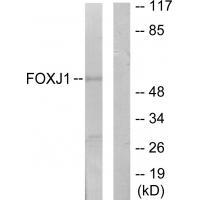
| WB | 1/500-1/3000 | Human,Mouse,Rat |
| IF | 咨询技术 | Human,Mouse,Rat |
| IHC | 咨询技术 | Human,Mouse,Rat |
| ICC | 技术咨询 | Human,Mouse,Rat |
| FCM | 咨询技术 | Human,Mouse,Rat |
| Elisa | 咨询技术 | Human,Mouse,Rat |
| Aliases | Forkhead-related protein FKHL13; Hepatocyte nuclear factor 3 forkhead homolog 4; HFH-4; |
| Entrez GeneID | 2302; |
| WB Predicted band size | 60kDa |
| Host/Isotype | Rabbit IgG |
| Antibody Type | Primary antibody |
| Storage | Store at 4°C short term. Aliquot and store at -20°C long term. Avoid freeze/thaw cycles. |
| Species Reactivity | Human,Mouse,Rat |
| Immunogen | Synthesized peptide derived from internal of human FOXJ1. |
| Formulation | Purified antibody in PBS with 0.05% sodium azide. |
+ +
1. **"Foxj1 transcription factors are master regulators of the motile ciliogenic program" by Yu, H., et al.**
摘要:该研究利用FOXJ1抗体通过免疫染色和ChIP-seq分析,确定了FOXJ1在纤毛形成中的核心调控作用,揭示其直接激活纤毛运动相关基因的表达。
2. **"Foxj1 regulates asymmetric gene expression during left-right axis patterning in mice" by Chen, J., et al.**
摘要:通过FOXJ1抗体的免疫组化实验,研究发现FOXJ1在小鼠胚胎左右体轴发育中调控纤毛功能,缺失导致内脏器官异位等发育缺陷。
3. **"Characterization of Foxj1 target genes in the olfactory epithelium" by Iwata, T., et al.**
摘要:使用FOXJ1抗体进行蛋白质定位及敲除模型分析,揭示其在嗅觉上皮细胞中调控纤毛结构和气味信号传导的关键作用。
4. **"FOXJ1 as a diagnostic marker for primary ciliary dyskinesia" by Horani, A., et al.**
摘要:通过患者呼吸道样本的FOXJ1抗体检测,发现其表达异常与纤毛运动障碍相关,提出其作为原发性纤毛运动障碍的潜在诊断标志物。
FOXJ1 (Forkhead box J1) is a transcription factor belonging to the forkhead box (FOX) family, characterized by a conserved winged-helix DNA-binding domain. It plays a critical role in ciliogenesis, mucociliary differentiation, and the development of motile cilia and flagella. FOXJ1 is expressed in ciliated epithelial cells of the respiratory tract, brain ependyma, and reproductive organs, where it regulates genes essential for ciliary assembly and function, such as dynein motor proteins.
FOXJ1 antibodies are widely used in research to identify ciliated cell populations and study mechanisms underlying cilia-related disorders, including primary ciliary dyskinesia, hydrocephalus, and chronic respiratory diseases. These antibodies detect FOXJ1 protein via techniques like immunohistochemistry, immunofluorescence, and Western blot, enabling visualization of ciliated cell distribution and differentiation status. Recent studies also implicate FOXJ1 in cancer progression, where its aberrant expression correlates with tumor metastasis or suppression depending on tissue context.
Commercially available FOXJ1 antibodies are typically raised against specific epitopes of human or mouse FOXJ1. with validation in relevant models. Researchers must optimize protocols due to potential cross-reactivity or tissue-specific isoforms. Its role in cellular motility and signaling continues to make FOXJ1 a key target in developmental biology, regenerative medicine, and disease pathogenesis studies.
×